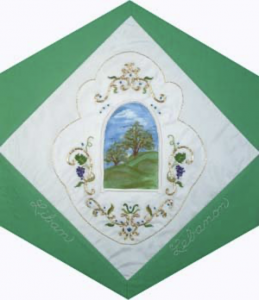Lebanon

The Block
Through the arched window of this piece Rita Attieh has created a picturesque view of the famous Cedars of Lebanon which dot the slopes of Mount Lebanon. The trees––historically used to build, among other things, ships and palaces––once covered the mountains of Lebanon but now only about 300 remain. Known as Arz ar-Rab (Cedars of the Lord), they rise to heights of more than 30 metres (100 feet) with a girth of 15 metres (50 feet). Some are believed to be 1,500 years old. These majestic and indestructible trees which French poet Alphonse Lamartine says, “know the history of the earth better than history itself”, symbolize not only strength, holiness and eternity, but the Lebanese spirit as well. Couched gold scrolls and finely embroidered grape vines gently wind their way around the window. The grapes depicted in the block are symbolic of wine. One of Lebanon’s main crops are its grapes and wine has become part of daily life in many Lebanese homes.
Cultural Profile
Lebanon––considered to be one of the fifteen lands comprising the so-called “Cradle of Humanity”––is located on the eastern coast of the Mediterranean Sea in southwest Asia. Although a small country, it is divided into four distinct regions: a narrow coastal plain along the Mediterranean shore, the Lebanon Mountains (often called Mount Lebanon), the Beqaa Valley (a fertile between-mountain basin) and the ridges of the Anti-Lebanon Mountains. The country’s name comes from the Semitic “Laban” (white), which refers to its snow-covered peaks.
Lebanon is the site of the ruins of Sidon, built by the Phoenicians who also developed the first alphabet. It is also home to Byblos, one of the world’s oldest continuously inhabited cities, from which the word ‘Bible’ is derived. Over 90 percent of the population is Arab, and Arabic is the official language. French and English are also widely used. Lebanon is the most religiously diverse Arab state. Muslims account for 54% of the population while Christians account for 40%, and Druze, 5.6%. Even though these various communities have been historically associated with some regions of the country, they all converge in Beirut’s melting pot, where mosques and churches stand side by side with nightclubs and trendy cafes.
Lebanon’s rich history, shaped by many cultural traditions, is a blend of East and West, and past and present influences. Poetry, including the popular form known as zajal, and literature play important cultural roles, as do folk music and dancing. Instruments include the oud (a pear-shaped string instrument), the tabla (a clay, wood or metal and skin percussion instrument), the nay (an open-ended pipe) and the qanun (a flat, string instrument). The dabke, Lebanon’s lively national dance, has become the country’s most famous tradition, performed everywhere from in the home, to restaurants, nightclubs and parties.
Lebanese arts and crafts, which have changed little through the centuries, include leather goods, copperwork, gold and silver smithing, ceramics, and the making of mishaba (worry beads). Since Lebanon has been a trading port for many centuries, and the last stop on the Silk Road, its textile arts are varied and go back to pre-Biblical times. It is there that Tyrian purple dye was discovered in 1500 BC. This pigment, which comes from sea snails found on Lebanon’s coast, was worth its weight in silver due to the fact that the colour became brighter with weathering and sunlight instead of fading. It eventually became a sign of wealth amongst Roman rulers, Byzantine emperors and religious officials. Silk was introduced from China and its production and nawl (weaving) remained a major industry until the Second World War, supplying mostly French markets with threads and woven cloth.
Waterproof goat hair is woven on large vertical looms to make Bedouin tents. Rug making, following Turkish tradition, is also popular. Embroidery was once part of every Lebanese girl’s education, as she was expected to start making her trousseau when she turned 10. It is a valued skill that continues, thriving in needlework associations and workshops. A distinctive piece of clothing in Lebanon is the abaya, the traditional long flowing Arabic robe, though the Lebanese version is often a trendy, colourful and embroidered version made locally.
The Lebanese community in Canada, which dates back to the 1880s, is one of the oldest non-European immigrant communities. Many early settlers, who prior to 1955 were listed on immigration records as ‘Syrian,’ were tradesmen who often became successful in commerce. As a result of the country’s civil war (1976-1990), the number of immigrants increased considerably and there are currently large Lebanese communities throughout Canada, particularly in Montréal, Ottawa and Toronto. Lebanese have established numerous associations, such as Ottawa’s Lebanese and Arab Social Services, and Toronto’s Cedars Social Club and the Canadian Lebanese Society. They have created special language schools to preserve and promote their culture. They’ve shared a taste of their heritage through restaurants and food stores nationwide. They have made significant contributions to many areas of Canadian society. As of 2011, there were 190,000 people of Lebanese descent living in Canada.
Sponsor: Ken MacLennan
